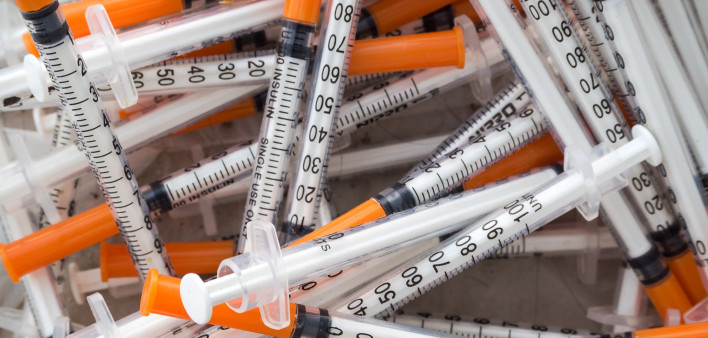Black people who inject drugs had the safest sexual behavior of any of the injection drug users surveyed by the Centers for Disease Control and Prevention (CDC) in 2018—but they still had HIV rates more than twice that of their white peers, according to data published in the CDC’s Morbidity and Mortality Weekly Report.
Some of that might be the result of another finding in the survey: Use of needle exchanges, or syringe services programs (SSPs), remained steady for every other group but not for Black people who inject drugs. For them, access to syringe services programs dropped from 51% to 40%. Likewise, Black people who inject drugs received new syringes from pharmacists less than twice as often as their white counterparts and were less likely to access medication-assisted treatment for opioid use disorder.
“Lower SSP use among Black [people who inject drugs] in the context of disproportionally higher rates of HIV diagnosis in Black communities might lead to increased risk for HIV transmission in Black [people who inject drugs],” wrote Senad Handanagic, MD, of the CDC, and colleagues. “It is critical to explore and address the causes for these disparities in SSP use and HIV infection rates.”
The data come from 14,716 people living in 23 U.S. metropolitan areas, which included Atlanta, Baltimore, Miami, Memphis, Houston, Detroit, Denver, Philadelphia, San Diego, Newark and Washington, DC. The majority lived in the Northeast (36%) or the South (29%). Among those tested, 6% were HIV positive. In addition, 42% were white, 32% were Black, 24% were Latino. Most of the results were for people exposed to HIV through heterosexual contact or syringe sharing.
The overall weighted HIV prevalence for all participants was 7%. But for Black participants, that rate was 12%—more than twice the rate among white participants (5%) and not quite double the rate of Latino participants (7%).
When the researchers broke down the data by risk behaviors, however, they saw a different picture. Black participants were half as likely as their white peers to report using a needle that someone else had already used (receptive syringe sharing)—16% compared with 36% of white participants and 22% of Latino participants. They were also less likely to use someone else’s “works,” or injection equipment (38% versus 59% among white participants). Black and Latino participants were less likely than their white peers to report condomless vaginal sex (63% versus 73%). And while 16% of Black participants reported having condomless heterosexual anal sex, that rate was 24% among white participants.
Latino and Black participants also were more likely to report testing for HIV in the past year (62% of Latino, 59% of Blacks and 53% of whites) and were more likely to report having participated in an HIV prevention program in the last 12 months (37% of Latinos, 34% of Blacks and 29% of whites).
It was medical care and interactions with clinicians where Black participants fell off. Black participants were less likely ever to have been tested for hepatitis C (80% versus 85% for Latinos and 86% for whites) and less likely to receive sterile syringes from SSPs (40% compared with 63% for both Latino and white participants). When it came to accessing clean syringes from pharmacies, Black participants reported doing that less often than their white counterparts (20% compared to 33% of Latinos and 46% of whites). And Black participants were the least likely to access medication-assisted treatment for opioid use disorder (47% versus 58% of whites and 65% of Latinos).
“For progress to be made toward achieving the goals of the federal ‘Ending the HIV Epidemic in the United States’ initiative, [people who inject drugs] need to have low-barrier access to comprehensive and integrated needs-based SSPs (where legally permissible) that include provision of sterile syringes and safe syringe disposal, HIV and HCV testing and referrals to HIV and HCV treatment, HIV pre-exposure prophylaxis and treatment for substance use and mental health disorders,” the researchers concluded.
Click here to read more news about people who inject drugs and the U=U movement.







Comments
Comments